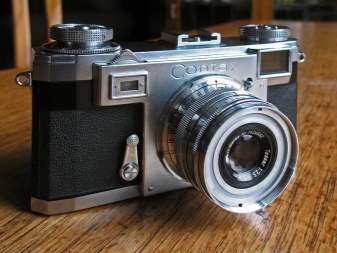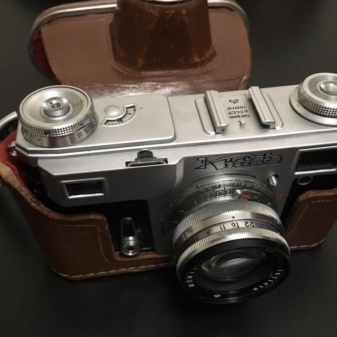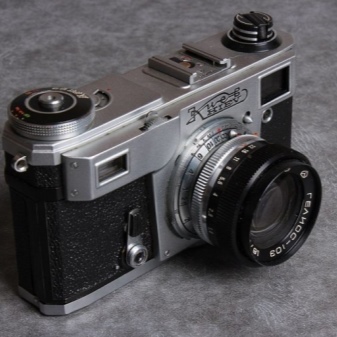Cameras "Kiev"

Cameras "Kiev" were produced in the USSR after the war. The first models were produced on German equipment, then production began at the Kiev plant "Arsenal".
History of creation
Zeiss Ikon in 1936 launched the production of cameras in the series Contax... These models were considered one of the best devices of their time. The advantages of this camera were considered:
- rangefinder with a wide nominal base;
- improved shutter;
- small format;
- bayonet connections of high-aperture optics.


After the end of the war, the rights to own trademarks were revoked for Germany, and the copying of German developments that took place in the pre-war period was allowed. Many countries have taken advantage of this opportunity. A few years later, Japan released a series of cameras Nikonin many ways similar to the Contax model.
The German plant, where the photographic equipment was originally produced, was supposed to stop working and be dismantled during the Yalta agreement. Technique, equipment and documentation were redirected to the USSR. At first, they wanted to launch the production of photographic equipment in Kazan, and the name “Volga” was also invented for the new model of cameras.


But in the end, the equipment was delivered and installed at the Arsenal plant in the city of Kiev.... Cameras that were assembled from German parts were named "Kiev". Component parts were still designated Contax. The models produced at the plant were exactly the same as German cameras, however, this was not advertised. Soviet models retained all the advantages of an imported camera:
- rewind the tape with a simple press;
- the convenience of the release button;
- quiet sound of work.
For the beauty and status of the camera, the body was covered with natural leather. However, this was unprofitable, in case of technical malfunctions of the rangefinder, the skin had to be removed.
Over time, instead of natural leather, they began to use leatherette, which made the camera available to a larger number of consumers. Thanks to this change, the price of cameras has come down.

More than 4,000 cameras in the Kiev line were assembled from parts delivered by Germany between 1946 and 1949. At the end of 1949, the use of parts produced in the Moscow region began. The lenses were assembled at a mechanical plant in the city of Krasnogorsk; the supply of lens units continued from Germany. Since 1954, the production of Soviet glasses began according to new calculations.


Over the long years of production, cameras changed only in shape and slightly changed their cosmetic characteristics, the key technical settings were unchanged. They even retained the minus of the original cameras - the inconvenient placement of the rangefinder window, the main disadvantage of which was the overlap of the window with your fingers, which prevented full capture. Over time, the equipment began to wear out, the general production culture began to decline, and the Kiev cameras lost the status of highly reliable technology - in 1987 their production was discontinued.

Model range of cameras
During the period of production of cameras, there were released several series "Kiev"... The typeface and design markings have changed several times during the entire production period. The model was not indicated on the device itself, it was possible to distinguish it based on external signs and by the year of manufacture. It was displayed in the first two digits on the serial number.

There were two main lines of cameras produced:
- With exposure meter... This range is similar in technical parameters to the Contax III model. Analogues produced at the Arsenal plant are the Kiev-III models and other improved devices of this line.
- Without exposure meter... These models began to be produced based on the technical characteristics of the German Contax II camera. These are the Kiev-II models and other advanced devices of this line. Line II and III in modern literature are designated by Arabic numerals, however, during the years of production it was customary to use Roman ones. Linear row II and III, at the end of which the symbol "A" was added, differed in their characteristics from the originals of Contax - they had a sync contact function.


The general lineup of cameras produced from the 1940s to the 80s had few differences. In 1976, the “M” model was released, which had a number of characteristics inherent only to it:
- the shutter cocking handle has been modernized;
- improved film rewinding;
- shortest shutter speed 1/1000 sec .;
- rewinding with a folding head;
- the take-up spool is built-in and cannot be removed;
- the body is made with plastic inserts.

Cameras models "Kiev-30" differed from most of the models in the line. Miniature cameras have been adapted to accommodate 16 mm film. The model has been produced since 1975. The film camera had a number of distinctive characteristics:
- the frame size of this camera is 13 × 17 mm;
- despite the miniature size, there was an aperture with the ability to restore parameters from f3.5 to f11;
- the size of the fit film is 45 or 65 cm, on which it was possible to take 17 or 25 frames;
- metal shutter in the form of curtains, with a choice of 3 exposure parameters 1/30, 1/60, 1/200, when using any exposure parameter, the window will fully open.


The model also had disadvantages:
- lack of rewind;
- the presence of a synchronizer on a miniature camera, the size of which did not correspond to most of the flashes produced in the USSR;
- lack of a flash lock.
The camera body was made of two divisions. Most of the case is housed in an external hard case. The chamber was 8 centimeters wide. Before shooting, the camera had to be ready. Another advantage of the model is the viewfinder. Possibility of choice of film sensitivity:
- bright sun;
- sunny;
- the sun behind the cloud;
- cloudy.


"Kiev 30" - a miniature handy device. It has full-fledged functions, there is focus and exposure. The case looks solid when unfolded and folded. Kiev-19 - this model was launched in 1985. The camera was an improved version models "Kiev-20".
Distinctive characteristics:
- lens mount - H mount;
- there is a repeater;
- standard lens - MC Helios-81N;
- mechanical shutter with vertical movement of two pairs of metal lamellas;
- the ability to work without batteries;
- non-volatile shutter;
- flash sync 1/60;
- wired sync contacts;
- viewfinder size 23 × 35 mm;
- the viewfinder covers up to 93% of the frame area.


The design of the model was virtually identical to the Kiev-20, which was quite natural. The side parts of the hull were changed, they began to be placed a little lower, in connection with which vertical sections appeared on the sides. On the left, the shutter speed head and the bayonet lock pedal were placed lower. There are no changes on the right side. The models do not have a metering button. The switch is combined with a diaphragm repeater, the measurement is made at the time of operation.
The first photographic equipment "Kiev" inherited German reliability, but had a complex shutter and rangefinder system.
The repair of the cameras was a laborious process, which was handled by the skilled craftsmen. These cameras were also distinguished by their high cost, a simple model of "Kiev" without an exposure meter was sold for 135 rubles.

In the mid-1970s, photographic equipment "Kiev" began to give up its positions to the new mirror technology. Cameras were in demand among consumer photographers. In a professional environment, where fast and high-quality shooting was needed, they began to use single-lens reflex cameras. In the 1980s, Arsenal began producing mirror and medium format models. Cameras gained popularity again after the rebuild, when it became known that the models were the prototype of German photographic equipment.


How to use?
Cameras of the "Kiev" line did not differ in the complexity of use, however, they had a certain algorithm of actions... The film was loaded into a cassette, where there were 2 rollers: the supply and the receiving, they could not be separated. To insert the film into the camera, you need to fix the latch at the bottom of the case, pull the inner and outer parts in different directions. Then open the metal cover and take out the cassette, on which the film is installed.
Before shooting, the camera was brought to readiness, first the body was pushed out to the right beyond the protruding edge, so that the camera unfolds and becomes a little wider. At this moment, the frame was transported, the shutter was cocked. The focusing dial and release hook can then be used. The viewfinder is used in an unfolded state. When closed, nothing is visible except the metal of the inner case.


There are two eyes on the front of the camera. Large - viewfinder, small - lens protector. For the convenience of determining the position of the shutter, a red dot is displayed in the lens window in the cocked shutter mode, when released, it is absent. The exposure of the frame is regulated by two dials on the right side of the case. The distance scale is located on the wheel.
The shutter speed changes both with the shutter cocked and with the shutter released. The descent hook is conveniently located, the descent is moderately tight. A self-resetting frame counter is located on the bottom of the model. The left side of the case is empty. Exposure control is set on a circular film speed panel. There are 2 bulbs in the viewfinder, the top one lights up when there is an excess of light, the bottom one when there is a lack.
With the right light, the bulbs should flicker alternately. The amount of light is changed by adjusting the shutter speed and through the aperture ring.

The following video provides an overview of the Kiev camera.













The comment was sent successfully.